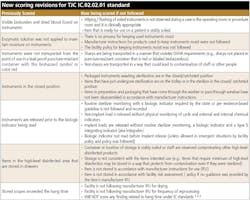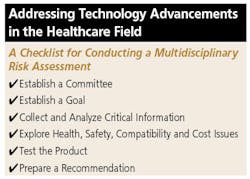TJC survey enhancements focus on sterilization and high-level disinfection
The Joint Commission (TJC) now incorporates enhanced evaluations during their on-site survey in four key areas they feel could pose the most risks to patients if they fail. The four targeted areas are:
- Sterile medication compounding
- Suicide prevention
- Hemodialysis
- High-level disinfection (HLD) and sterilization 1, 2, 3
TJC surveyors are currently instructed to take a deeper look into these four high-risk areas, and that means they will, more than likely, be spending focused time in any area/department that performs HLD and/or sterilization on instruments and equipment and the areas/department that use these devices.
TJC is putting an emphasis on reprocessing reusable medical devices because of all of the severe breaches in cleaning and sterilization they have observed and also those stories cited in the media.
The survey enhancements went into effect last fall. TJC Survey enhancement revisions appear to be setting their concentrated focus on the processing steps that pose the highest risks to patients if they fail. The emphasis appears to be on ensuring facilities follow evidence-based guidelines such as those published by the Association of periOperative Registered Nurses (AORN), the Association for the Advancement of Medical Instrumentation (AAMI), the Centers for Disease Control and Prevention (CDC) and the Association for Processionals in Infection Control and Epidemiology (APIC). They also will want to be sure organizations are rigorously following the manufacturers’ instructions for use (IFU) for the equipment, devices and the various chemicals. 1, 2, 3
TJCs Infection Control (IC) standard IC.0.02.01 requires healthcare organizations to decrease the risks of infections associated with medical equipment, devices and supplies. This IC standard is one of the most routinely cited non-compliance standards. TJC shared a compare and contrast of how this standard was previously scored and how it will now be scored (see insert).1, 2, 3
In my opinion, TJC is headed in the right direction as their surveyors are being trained to the new expectations which are now based on current published professional standards and guidelines.
In addition to the new scoring revisions listed above, many facilites have reported that surveyors are inquiring how cleaning is being verified and how mechanical cleaning equipment is being monitored for efficacy. It has been well established that mechanical cleaning is preferred over manual cleaning, unless otherwise specified by the instrument manufacture’s written IFU.4
Mechanical washers, which include washer–disinfectors, automated endoscope reprocessors (AERs), ultrasonic cleaners and other mechanical cleaning equipment, provide consistency, reduce the risk of exposure to personnel and are more easily monitored for quality than manual cleaning. Efficacy testing of mechanical washers is extremely important to help diagnose if the equipment is functioning correctly and should be part of an overall quality management program for processing areas/departments.4
According to AAMI, healthcare personnel should perform cleaning verification testing on all mechanical cleaning equipment. Methods of verification include:
- directly testing individual instruments for residual soils (e.g., adenosine triphosphate [ATP], protein, hemoglobin);
- employing a test device that is a consistent and repeatable challenge to the cleaning effectiveness of the equipment; and
- monitoring critical parameters to evaluate the performance of the mechanical cleaning equipment.5
Mechanical cleaning equipment should be tested:
- upon installation,
- each day that it is used, and
- after major repairs (i.e., software upgrade or water pump replacement, detergent delivery system, heating system, water delivery system, water treatment system, ultrasonic generators or computer controls).5
Everyday monitoring is required in order to ensure that mechanical cleaning equipment is working properly and according to the manufacturer’s instructions for use. Testing the equipment upon installation, daily during routine use, and after repairs allows the facility to confirm its continued effectiveness. 4,5 Reviewing and initialing the readouts and cycle printouts confirms that the mechanical equipment completed all the essential phases of the cycle.5
Staff working in hospitals, critical access hospitals; ambulatory care and office based surgery facilites should be familiar with TJC updated enhanced survey evaluations as well as the most current standards and guidelines published by the professional organizations. By following these standards, an organization can reduce risks to patients, personnel, failing an accreditation survey or and/or exposure to the media for poor cleaning and sterilization practices.
Reference
1. The Joint Commission. 4-1-1 on Survey Enhancements: New scoring revisions for IC.02.02.01 now in effect, posted 9/5/2018. Available at https://www.jointcommission.org/issues/article.aspx?Article=G%2FxUdh%2FVKujxJ12FY7q2i0ousSBZsyucrGSdk%2BHj1O8%3D. Accessed 8/5/2019.
2. The Joint Commission. Get the 4-1-1 on Survey Enhancements: New series from The Joint Commission. Available at: https://www.jointcommission.org/issues/article.aspx?Article=WCFwZQljVp/BaABRTnX5jX49fz4VQmyeVn9IQHP7lqw=. Accessed 8/5/2019
3. Garcia-Houchins, S. Disinfection and Sterilization: Dispelling the Myths, Webinar. Available at: https://www.jointcommission.org/disinfection_and_sterilization_dispelling_myths/. Accessed 8/5/2019
4. Guideline for cleaning and care of surgical instruments. In: Guidelines for Perioperative Practice. Denver, CO: AORN, Inc; 2019.
5. ANSI/AAMI ST79:2017. Comprehensive guide to steam sterilization and sterility assurance in health care facilities. Arlington, VA: Association for the Advancement of Medical Instrumentation.
About the Author

Rose Seavey
Rose Seavey MBA, BS, RN, CNOR, CRCST, CSPDT, is an Educational Consultant to 3M Health Care. Ms. Seavey is President/CEO of Seavey Healthcare Consulting. Ms. Seavey is the 2019 recipient of the AAMI Standards Developer Award. Ms. Seavey is the author of the book tilted Sterile Processing in Healthcare Facilities: Preparing for Accreditation Surveys, published by AAMI, now in its third edition.


